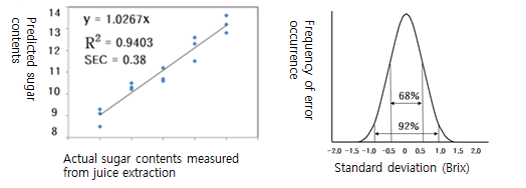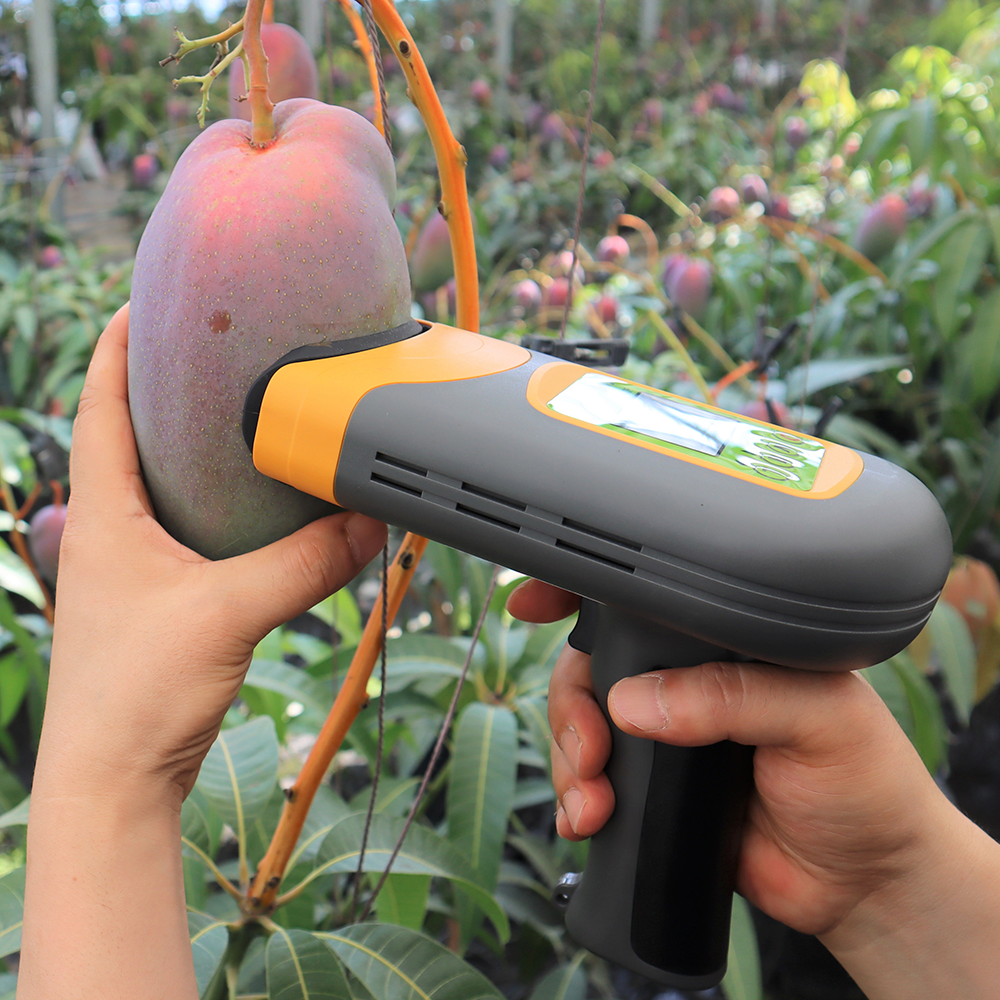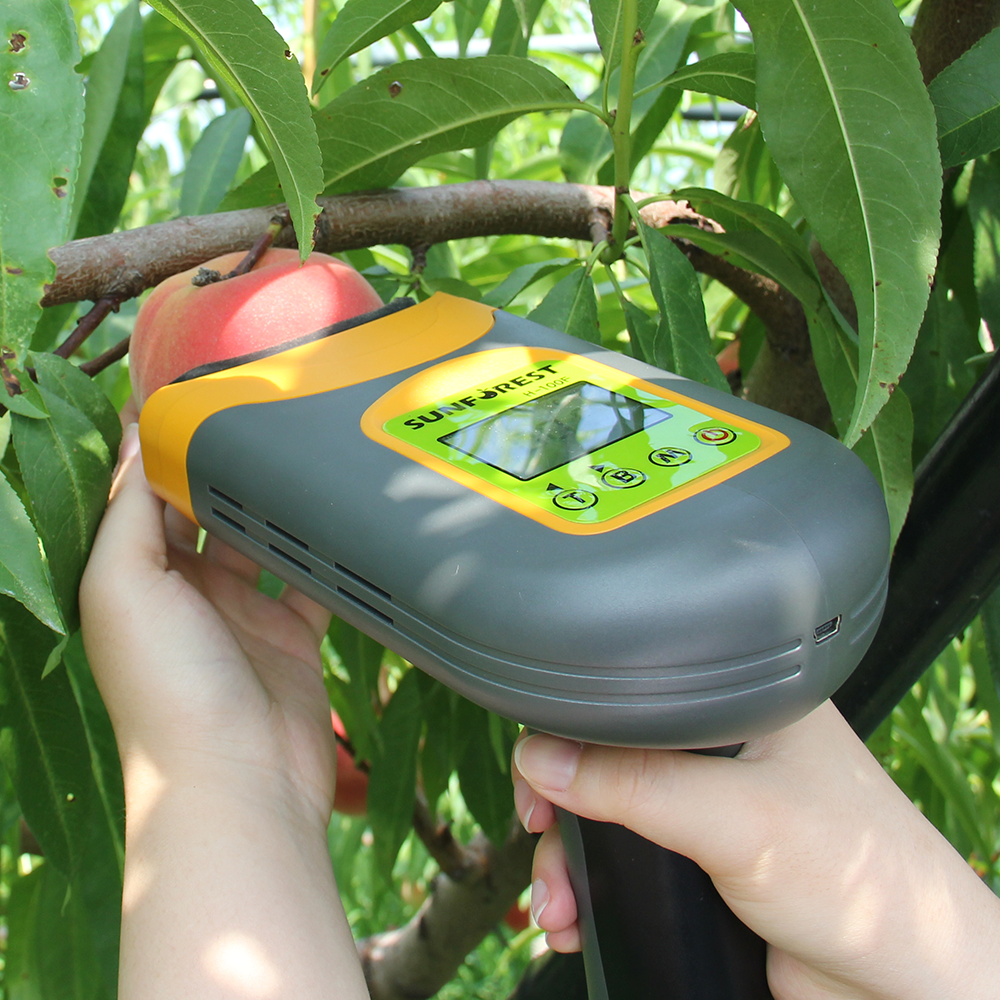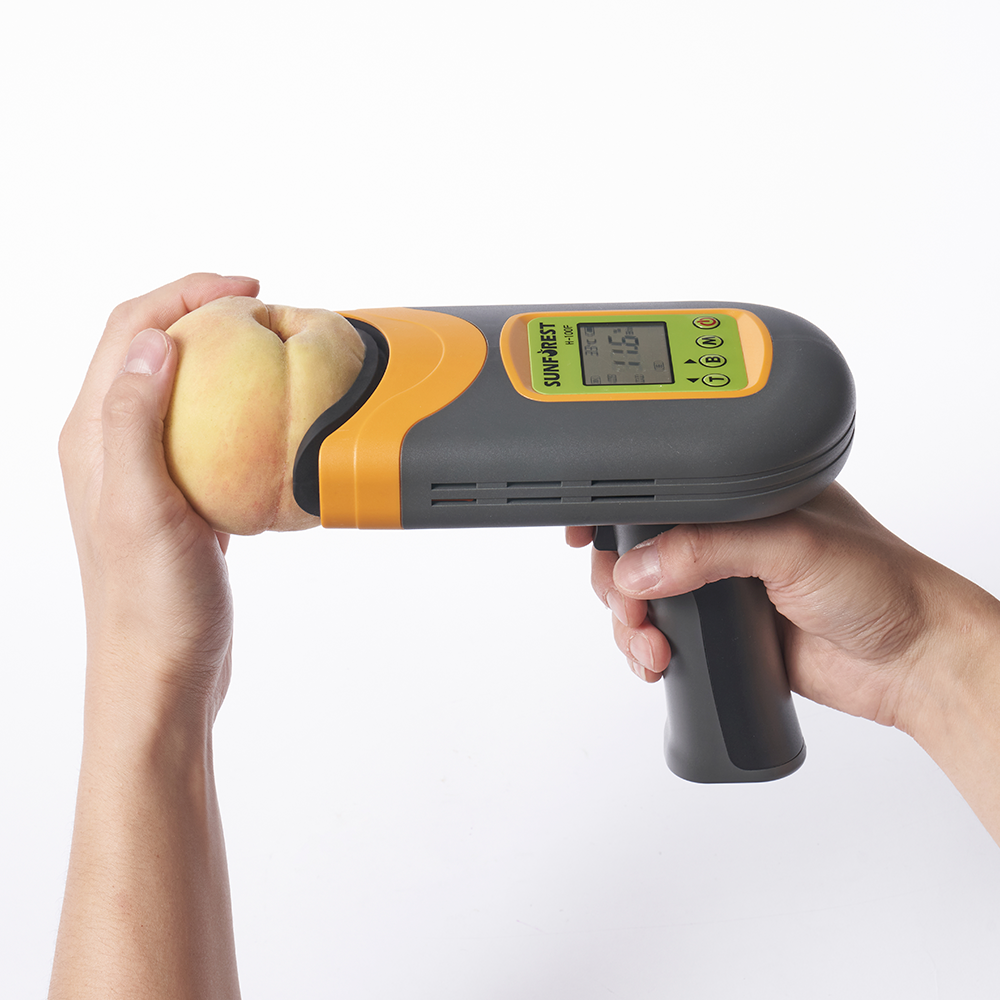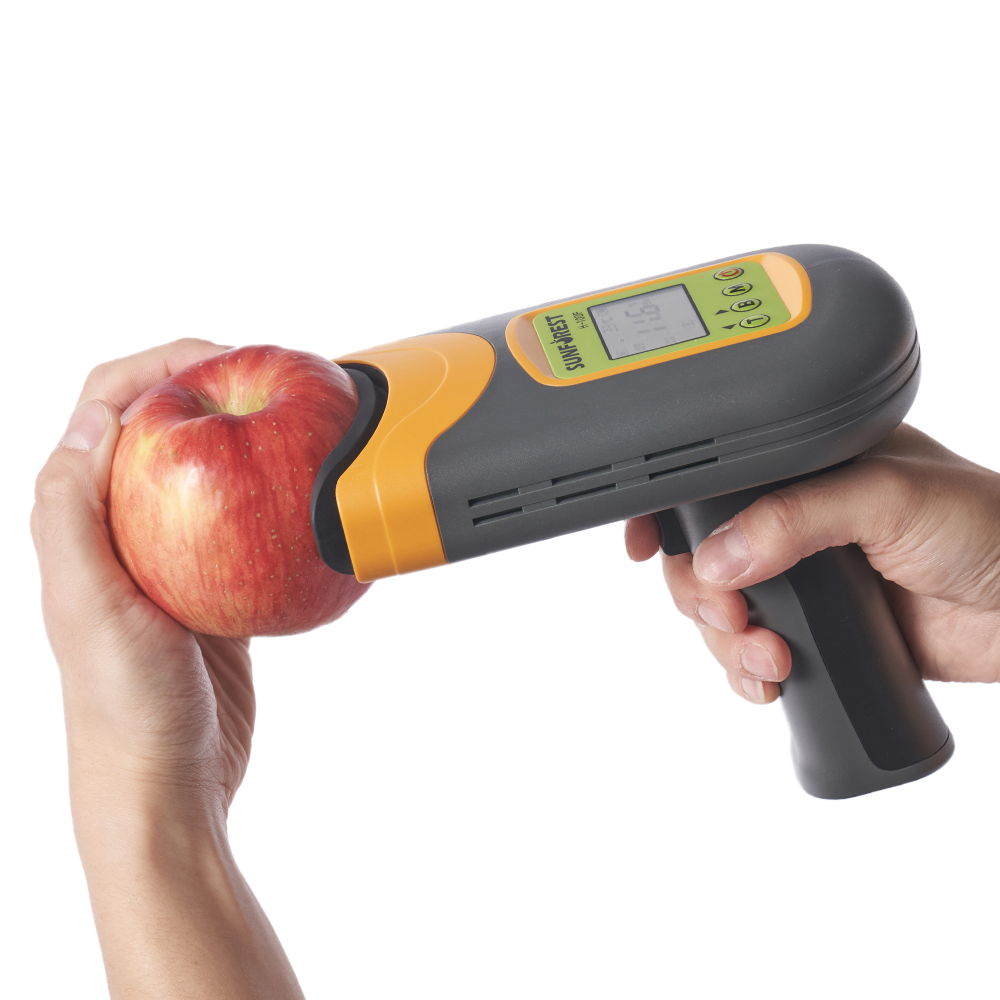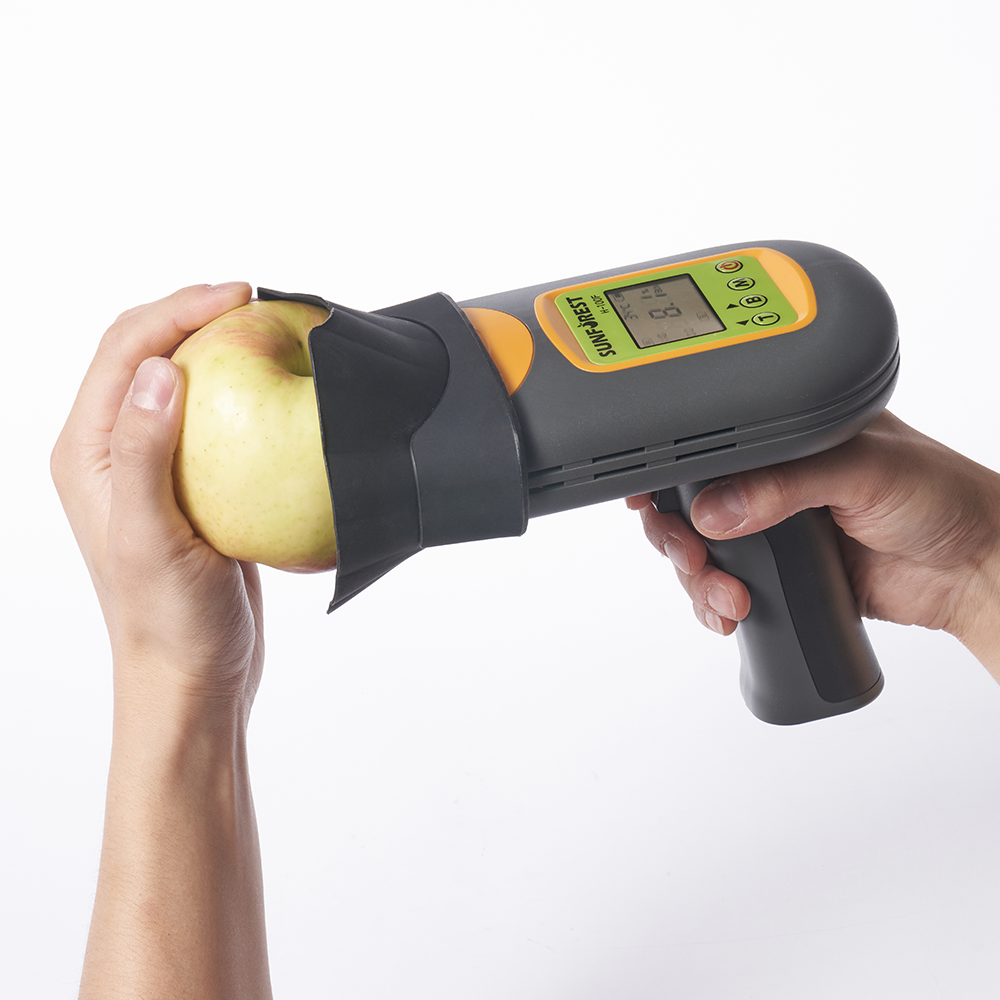H-100F

Portable Nondestructive Fruit Quality Meter
The H-100 is a portable, non-destructive instrument that measures the internal quality of fruit using semi-transmissive, diffuse reflection, near-infrared (NIR) spectroscopic analysis technology. It can be used to help determine harvest times and to make decisions based on the analysis of fruit growth quality in the orchard.
Trusted by thousands of clients in the fruit industry, the SUNFOREST H-100F has proven to be a reliable instrument for determining and tracking Brix, Dry Matter (DM), and Browning (Apples).
A demonstration model is included for the fruit that you select. A bias correction should be made by comparing the nondestructive prediction to the actual value of the juicing refractometer. If desired, models can be upgraded to your exact fruit variety. Perform comparative tests with the H-100F to destructive measurements, then send this to us and a new model will be built for you. Then download this to your meter for better accuracy.
GPS Application (by option): The H-100F is compatible with GPS application to show a travel line on orchard map and indicates DM and Brix dots along the path of samplings.
- Apple Brix/DM/Browning detection
- Peach Brix
- Mango Brix/DM (DM available on green-red mangos)
- Pear Brix/DM
- Persimmon Brix
- Grape Brix (available on Shine-muscat and Campbell which has large ball and no gap in the cluster, should work with any type of grape with no gap in the cluster)
- Provides simple and rapid sugar content / TSS / Brix measurement
- Can be used for bulk, on-orchard maturity determination
- Measures without damaging the sample
- Quick and easy, diagnosis of the internal fruit quality
- Accurate and repeatable results with automatic temperature compensation
- Bluetooth connection to a dedicated mobile app
- Smartphone app allows the user to view and save measurements, display statistical distributions (histograms), correct deviations and select fruit
- One-year warranty with predictive calibration upgrades as necessary
- Includes meter, storage case, rubber shading, measuring area cover, cleaning tool, dedicated charger and user manual
| Category | Specification |
|---|---|
| Metrics |
Sugars (Brix), Dry Matter (%), Browning (Browning Index) Metrics may vary by fruit. Browning is available for apples only. |
| Measurement range |
Sugars 5.0 to 25.0 Brix 5.0 to 40% Dry Matter Browning index 0 to 100 Measurement range may vary by apple variety. Browning index 0 to 100 is an established Sunforest standard. Browning level 20 is set as cutoff line. Less 20 is regarded as normal, 20+ as abnormal (browning). |
|
Accuracy (Standard error of calibration) |
Sugars ±0.3~1.0Brix Dry Matter 0.8-1.5%x |
| Measure Speed | ~2.0 seconds, depending on the size and condition of the fruit |
| Environment | 5°C to 40°C (41°F to 104°F) | 85% RH or less |
| Interface | USB C-type | Bluetooth 4.1 |
| Sensor | Enhanced CMOS Spectrometer (640 – 1,050 nm) |
| Light Source | Xenon Lamp |
| Power | Rechargeable Lithium-Ion (3500mA) | 12VDC/3.0A Adapter |
| Battery Life | 3000 scans, when fully charged |
| Weight | 450g(0.99 lbs.) |
| Dimensions | 110 x192 x172mm(4.3” x 7.6” x 6.8”) excluding cap |
※ Correlation coefficient and standard error of the calibration model
The predicting performance of a nondestructive measuring instrument can be evaluated by correlation coefficient((R2) and standard error(SEC) of the calibration model.
The correlation coefficient indicates the level of co-relationship between the sugar contents predicted by calibration model and actual sugar contents of extracted juice measured by refractometer. Bigger the correlation coefficient of the calibration model, better the definiteness between high sugar contents and low sugar contents. Thus we can tell the calibration model with bigger correlation coefficient is better optimized to object fruit. The standard error is the statistic distribution of error range between sugar contents predicted by calibration model and actual sugar contents measured from the juice extracted. A standard deviation of 0.5 Brix means that among the total number of measurement, about 68% can predict the sugar contents within the error range of ±0.5 Brix. Thus, in some cases, a measurement error may have larger value than 0.5 Brix. To create a calibration model with good correlation coefficient and useful standard error, it is recommendable to make models collected from various range of sugar contents and considerable number of fruit samples. The correlation coefficient and standard error should be made to be suitable for desired purposes of instrument use ; make decision of harvesting time or selection of favorable fruit at post-harvest And the calibration model should be created in consideration of the varieties of fruit and area/time of cultivation.
